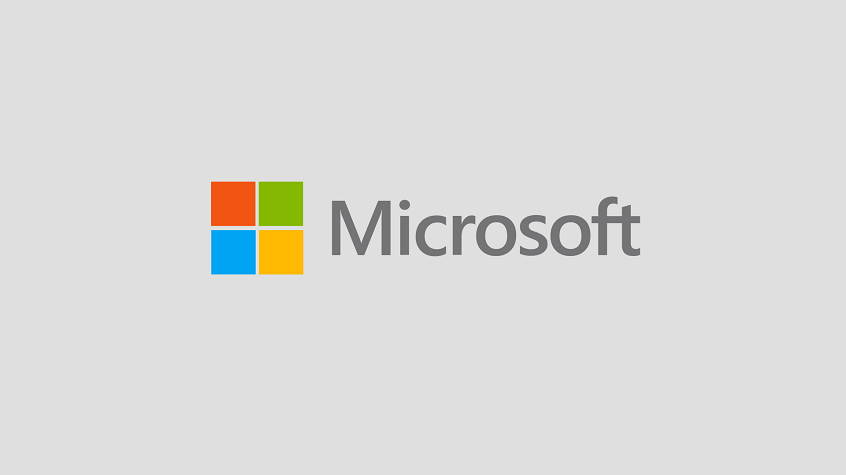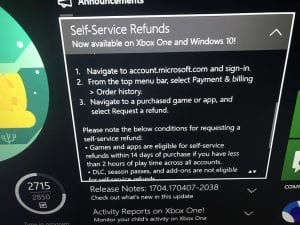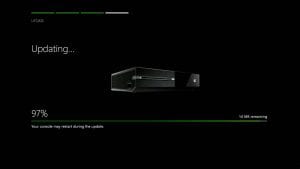Microsoft will now offer a self-refund policy to all Windows 10 and Xbox One purchases. This is the latest consumer friendly change that will help current and potential Xbox owners. Steam was the first platform that offered a refund to its consumers in 2015. Steam needed this feature because of botched game launches like Assassin Creed Unity and Batman: Arhkam Knight. This may be a company wide policy change for Microsoft’s Window 10 and Xbox platforms but it carries new implications to a all digital future.
Microsoft is launching a service for self-refunds for any game (excluding DLC, game add-ons, etc.) on your account. Knowledgeable consumers have to access their account on microsoft.com in order to request a refund on a digital purchase. Let’s say you buy a copy of Yooka-Laylee and you are unsatisfied with your purchase. The refund system allows the consumer to request a refund if they have launched the game, played less than 2 hours, and is still within 2 weeks of purchase. The requirements for a refund seem fair and it protects Microsoft from abuse. This is a game changer because this feature is now coming to consoles and now both Sony and Nintendo will have to respond accordingly. There will be growing pains for small indie developers whose games can be beaten in less than 2 hours. Big publishers might also extend the beginning of the game in order to pass the 2 hour mark to avoid being refunded. Xbox and Microsoft have given consumers better reasons to stay on their platform; game refunds, Xbox Live, Project Scorpio, Game Anywhere Program, Games with Gold. Sony and Nintendo will have to entice consumers in another way or implement its own refund policy if the demand is great enough.
Sony and Nintendo will often release several games a week through their digital store fronts. Having a refund policy can change the console landscape because of the amount of games we currently have; most of them are trash. Steam gained 40% of its available games in 2016 alone! It is almost impossible to play all these games for quality control and some games have been known to steal peoples money by reusing other video game assets. Sony’s PSN store gets a massive amount of downloadable games that are simply crappy games and having a refund policy would give consumers a way out from a bad purchase. Word of mouth is a powerful tool in marketing and people will recommend Xbox because of its consumer friendly policies. Nintendo has no problem not offering refunds because its fans will buy the same digital copy of Super Mario World on every system. Sony will be the most likely contender to implement change but can their company implement a smooth refund feature considering people still can’t change their PSN IDs? Sony is a popular and known brand in the electronic world but their networks and digital infrastructure are slow to adapt.
Only time will tell how Microsoft’s changes will impacts the gaming landscape as a whole. They are giving consumers the option to return digital purchases that they’re not happy with. AAA publishers who launch games that are broken or unplayable will now have to take refunds into consideration. The guide lines and rules that Microsoft have placed seem fair but having a option to refund a game on the console itself would be better. This marks a great moment in accepting an all digital future that Steam pioneered several years ago. Digital media has evolved in fast and crazy ways in order to keep up with on-demand content. Netflix, Hulu, and Amazon Video dealt a severe blow to physical copies of movies and television shows. Services like Spotify, iTunes, and Pandora also killed the physical music market; except for vinyl records. Microsoft is helping Xbox and Windows 10 become that next medium that will leave physical media behind in favor of on-demand digital games.
Retailers like Gamestop, Target, Amazon, and Walmart still sell millions of copies of physical games. PC games haven’t been sold in retailer stores since the mid 2000s and have completely adopted digital store fronts like Steam, GoG, and Origin. Xbox One and PS4 are selling more digital copies than the previous generation combined. EA has claimed that 30% of their games have been sold digitally on both consoles and that number will only increase year over year. NPD now also tries to account for retail and digital sales of hit video games every month. Steam flourished when it went all digital by having crazy amount of sales, mod support, and fun social features. The Xbox One now gained a step to an all digital future by offering refunds and great deals like Games With Gold. Console gaming will be the next in line to go all digital, but there are a couple of hurdles that need to be addressed.
Coastal cities in the United States have barely peaked 50 Mbps download speeds, while several rural areas don’t have internet access at all. Many PC gamers have a crazy good computer and try to obtain the fastest internet speed they can afford. Consoles are mainstream luxury items that families will buy for their kids or to entertain guests. The current infrastructure simply isn’t ready to handle the amount of data needed to support an all digital gaming console, at least not right now. Games have only gotten bigger with 40+ gig downloads and 10+ gig patches on release day. Internet providers adopted the data plans of smart phones by placing data caps on household internet. Most internet providers will throttle downloads and not deliver the speeds customer are paying for; especially when they know they’re the only ISP in the area. Game downloads are huge and some games require several patches like Destiny and Halo 5: Guardians.
Microsoft is making great strides and decisions to ease consumers into buying games digitally. Xbox’s Play Anywhere program guarantees that all first party games will be available for PC, Xbox One, and Project Scorpio. Microsoft is leading the charge to invigorate their Xbox brand and the refund policy for digital games benefits their fan base and potential customers. Xbox is one step closer to developing a platform that is fair, fast, and powerful with new hardware power and digital incentives.
No related posts.









[…] my article about an All Digital Future, I mentioned […]